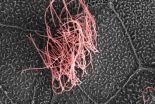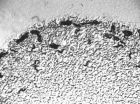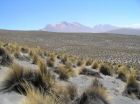(Press-News.org) La Jolla ---- Scientists at the Salk Institute for Biological Studies have identified a gene that tells cells to develop multiple cilia, tiny hair-like structures that move fluids through the lungs and brain. The finding may help scientists generate new therapies that use stem cells to replace damaged tissues in the lung and other organs.
"Cells with multiple cilia play a number of important roles, including moving fluids through the respiratory tract, brain and spinal cord," says Christopher R. Kintner, a professor in Salk's Molecular Neurobiology Laboratory, who led the research. "Knowing the gene that instructs cells to develop multiple cilia helps us understand how we might coax stem cells into developing into this type of cell, which we could then use to repair damaged tissue."
The findings of the research, which was supported by the National Institutes of Health and Salk's Innovation Grants Program, were published in the January 8 online issue of Nature Cell Biology.
Kintner and his collaborator, Jennifer Stubbs, a scientist now at Pathway Genomics, a San Diego biotech company, along with Eszter Vladar, a postdoctoral fellow in the laboratory of Jeffery Axelrod, at the Stanford University School of Medicine, made their discovery by initially studying the embryos of African clawed frogs (Xenopus laevis).
Multiciliate cells form on the outside of the embryos, making them easy to study, and the genetic mechanisms that direct the frog cells to develop multiple cilia are likely similar to those of humans.
Humans and other organisms inherited cilia from our single-celled primordial ancestors that used these beating structures as a form of propulsion. Most cells in our body project a single, non-moving cilium used as a tiny antenna for detecting chemical and physical stimuli. But certain specialized tissues require cells with 100 to 200 moving cilia that beat in concert to move fluids through the body.
These cells aid in pushing cerebrospinal fluid through the brain and spinal cord, helping to circulate and replenish this fluid. In the respiratory system, the cilia push mucus that traps dust, pathogens and other foreign matter from the lung up into the trachea, helping prevent infections.
In a previous study, published in Nature Genetics, Kintner and Stubbs identified a protein, FoxJ1, that promoted the formation of a single moving cilium. What remained unclear is how certain cells activate FoxJ1 in a way that leads to the formation of hundreds of motile cilia per cell.
In their new study, Kintner and his collaborators identified a gene that produces a second protein, which they dubbed "multicilin," that tells cells to develop multiple cilia. When cells are exposed to multicilin, their genetic mechanisms for developing multiple cilia are activated. In a developing embryo, the protein instructs certain stem cells that will line the lungs, kidney and skin to develop into multiciliate cells.
When the researchers inhibited multicilin's action, the frogs' skin and kidney failed to form multiciliate cells. The scientists also found that multicilin is both necessary and sufficient to instruct the development of multiple cilia in cells that line the airways of mice.
"This means that multicilin directs the development of these cells in a number of different organs," Kintner says. "How multiciliate cells develop had been a mystery, but this fills in a big piece of the puzzle."
Kintner notes that patients with respiratory diseases such as chronic asthma, emphysema and cystic fibrosis often suffer from lung infections, which may result from damage to the ciliated cells that move protective mucus out of the airways. In the future, stem cell therapies might replace those damage cells with new ciliated cells, but first scientists need to know how to guide stem cells along a pathway into multiciliate cells.
"Our findings suggest that multicilin could be central to differentiating stem cells into replacement cells," Kintner says. "It's a necessary step in developing such therapies."
INFORMATION:
About the Salk Institute for Biological Studies:
The Salk Institute for Biological Studies is one of the world's preeminent basic research institutions, where internationally renowned faculty probe fundamental life science questions in a unique, collaborative, and creative environment. Focused both on discovery and on mentoring future generations of researchers, Salk scientists make groundbreaking contributions to our understanding of cancer, aging, Alzheimer's, diabetes and infectious diseases by studying neuroscience, genetics, cell and plant biology, and related disciplines.
Faculty achievements have been recognized with numerous honors, including Nobel Prizes and memberships in the National Academy of Sciences. Founded in 1960 by polio vaccine pioneer Jonas Salk, M.D., the Institute is an independent nonprofit organization and architectural landmark.
Scientists identify gene crucial to normal development of lungs and brain
Discovery may lead to new ways to replace damaged lung tissues with stem cells
2012-01-13
ELSE PRESS RELEASES FROM THIS DATE:
Worm seeks worm: Caltech researchers find chemical cues driving aggregation in nematodes
2012-01-13
PASADENA, Calif.— Scientists have long seen evidence of social behavior among many species of animals, both on the earth and in the sea. Dolphins frolic together, lions live in packs, and hornets construct nests that can house a large number of the insects. And, right under our feet, it appears that nematodes—also known as roundworms—are having their own little gatherings in the soil. Until recently, it was unknown how the worms communicate to one another when it's time to come together. Now, however, researchers from the California Institute of Technology (Caltech) and ...
Discovery could help stem smoking-related diseases
2012-01-13
Sufferers of smoking related lung diseases could have their debilitating symptoms reduced following the discovery of a potential new treatment.
The discovery, by researchers at the University of Melbourne, Royal Melbourne Hospital, Australia, and the Brigham and Women's Hospital, Harvard Medical School, US, could dramatically improve treatments and slow the progression of COPD (Chronic Obstructive Pulmonary Disease) which includes the incurable condition emphysema.
COPD is a progressive disease that makes it hard to breathe and is mostly caused by excessive smoking. ...
Grapes may help prevent age-related blindness
2012-01-13
FRESNO, Calif. – Can eating grapes slow or help prevent the onset of age-related macular degeneration (AMD), a debilitating condition affecting millions of elderly people worldwide? Results from a new study published in Free Radical Biology and Medicine suggest this might be the case. The antioxidant actions of grapes are believed to be responsible for these protective effects.
The study compared the impact of an antioxidant-rich diet on vision using mice prone to developing retinal damage in old age in much the same way as humans do. Mice either received a grape-enriched ...
In tackling lead pollution, fungi may be our friends
2012-01-13
Fungi may be unexpected allies in our efforts to keep hazardous lead under control. That's based on the unexpected discovery that fungi can transform lead into its most stable mineral form. The findings reported online on January 12 in Current Biology, a Cell Press publication, suggest that this interaction between fungi and lead may be occurring in nature anywhere the two are found together. It also suggests that the introduction or encouragement of fungi may be a useful treatment strategy for lead-polluted sites.
"Lead is usually regarded as a pretty stable substance," ...
Boston College researchers locate protein that could 'turn off' deadly disease carrier
2012-01-13
CHESTNUT HILL, MA (Jan. 12, 2012) – Researchers from Boston College have discovered a protein that plays a pivotal role in the progression of the deadly diseases toxoplasmosis and malaria and shown that its function could be genetically blocked in order to halt the progress of the parasite-borne illnesses, the team reports in the current edition of the journal Science.
The protein, identified as DOC2.1, plays a similar role in the secretion of microneme organelles that are crucial to the mobility of the parasitic protozoa Toxoplasma gondii, which causes toxoplasmosis, ...
Diverse ecosystems are crucial climate change buffer
2012-01-13
Preserving diverse plant life will be crucial to buffer the negative effects of climate change and desertification in in the world's drylands, according to a new landmark study.
The findings of the multi-author study, published today in the journal Science, are based on samples of ecosystems in every continent except Antarctica.
They confirm for the first time that the more diverse an ecosystem is, the more ecological functions it performs. It also has implications for carbon sequestration and soil health.
"This is the most extensive study of the links between function ...
Conserving biodiversity could benefit the world's poor
2012-01-13
Land areas that are a priority for wildlife conservation provide relatively high levels of ecosystem services such as pollination, water purification, food production, and climate regulation, so safeguarding them is expected to benefit people. Assessing these benefits to populations in ways that are useful to decisionmakers who guide conservation efforts has, however, proved difficult.
A global analysis published in the January 2012 issue of BioScience by Will R. Turner of Conservation International and his colleagues breaks new ground by analyzing the flow of benefits ...
Scientists confirm tobacco use by ancient Mayans
2012-01-13
Archaeologists examining late period Mayan containers have identified nicotine traces from a codex-style flask, revealing the first physical evidence of tobacco use by ancient Mayans. The study published in Rapid Communications in Mass Spectrometry reveals the flask is marked with Mayan hieroglyphics reading, "y-otoot 'u-may," ("the home of its/his/her tobacco,") making it only the second case to confirm that the text on the exterior of a Mayan vessel corresponds to its ancient use.
"Investigation of food items consumed by ancient people offers insight into the traditions ...
The world's smallest magnetic data storage unit
2012-01-13
Scientists from IBM and the German Center for Free-Electron Laser Science (CFEL) have built the world's smallest magnetic data storage unit. It uses just twelve atoms per bit, the basic unit of information, and squeezes a whole byte (8 bit) into as few as 96 atoms. A modern hard drive, for comparison, still needs more than half a billion atoms per byte. The team present their work in the weekly journal Science this Friday (13 January 2012). CFEL is a joint venture of the research centre Deutsches Elektronen-Synchrotron DESY in Hamburg, the Max-Planck-Society (MPG) and the ...
Don't know much about charter schools
2012-01-13
Some two decades into the grand national experiment with charter schools, how much do we really know about them? Not all that much. And not nearly as much as we easily could, say researchers from the University of California, San Diego Division of Social Sciences.
Writing in the journal Science, UC San Diego educational economist JuIian Betts and Richard Atkinson, president emeritus of the University of California and former director of the National Science Foundation, find that most studies of charter schools "use unsophisticated methods that tell us little about causal ...
LAST 30 PRESS RELEASES:
Interaction of climate change and human activity and its impact on plant diversity in Qinghai-Tibet plateau
From addressing uncertainty to national strategy: an interpretation of Professor Lim Siong Guan’s views
Clinical trials on AI language model use in digestive healthcare
Scientists improve robotic visual–inertial trajectory localization accuracy using cross-modal interaction and selection techniques
Correlation between cancer cachexia and immune-related adverse events in HCC
Human adipose tissue: a new source for functional organoids
Metro lines double as freight highways during off-peak hours, Beijing study shows
Biomedical functions and applications of nanomaterials in tumor diagnosis and treatment: perspectives from ophthalmic oncology
3D imaging unveils how passivation improves perovskite solar cell performance
Enriching framework Al sites in 8-membered rings of Cu-SSZ-39 zeolite to enhance low-temperature ammonia selective catalytic reduction performance
AI-powered RNA drug development: a new frontier in therapeutics
Decoupling the HOR enhancement on PtRu: Dynamically matching interfacial water to reaction coordinates
Sulfur isn’t poisonous when it synergistically acts with phosphine in olefins hydroformylation
URI researchers uncover molecular mechanisms behind speciation in corals
Chitin based carbon aerogel offers a cleaner way to store thermal energy
Tracing hidden sources of nitrate pollution in rapidly changing rural urban landscapes
Viruses on plastic pollution may quietly accelerate the spread of antibiotic resistance
Three UH Rainbow Babies & Children’s faculty elected to prestigious American Pediatric Society
Tunnel resilience models unveiled to aid post-earthquake recovery
Satellite communication systems: the future of 5G/6G connectivity
Space computing power networks: a new frontier for satellite technologies
Experiments advance potential of protein that makes hydrogen sulfide as a therapeutic target for Alzheimer’s disease
Examining private equity’s role in fertility care
Current Molecular Pharmacology achieves a landmark: real-time CiteScore advances to 7.2
Skeletal muscle epigenetic clocks developed using postmortem tissue from an Asian population
Estimating unemployment rates with social media data
Climate policies can backfire by eroding “green” values, study finds
Too much screen time too soon? A*STAR study links infant screen exposure to brain changes and teen anxiety
Global psychiatry mourns Professor Dan Stein, visionary who transformed mental health science across Africa and beyond
KIST develops eco-friendly palladium recovery technology to safeguard resource security
[Press-News.org] Scientists identify gene crucial to normal development of lungs and brainDiscovery may lead to new ways to replace damaged lung tissues with stem cells


